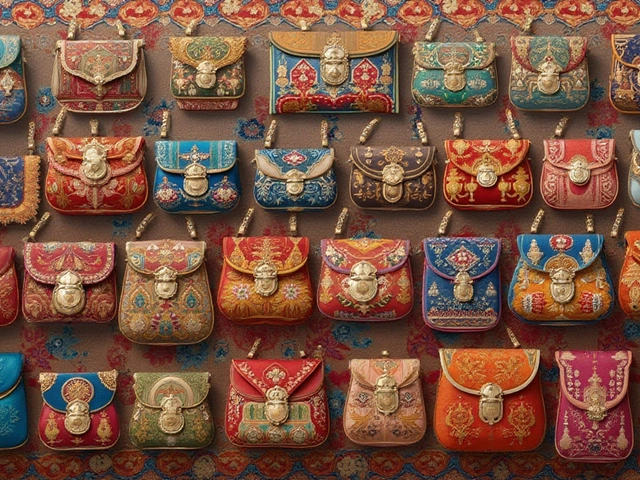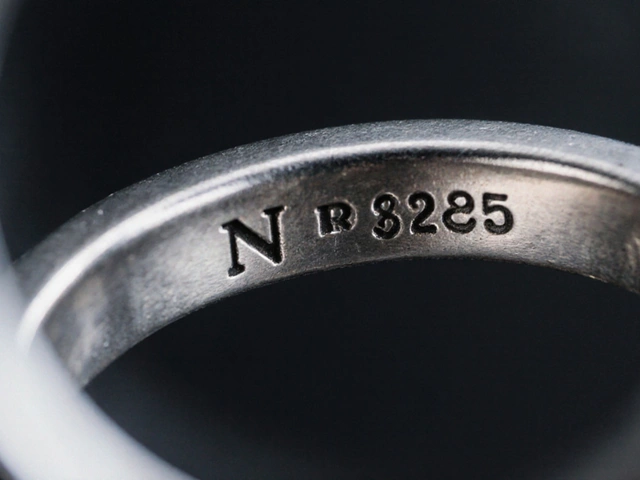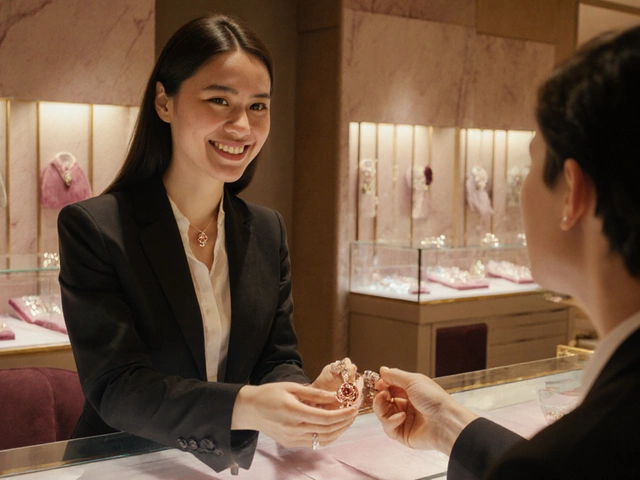
Dropshipping in the antique jewelry domain isn't just a trend; it's a business model that's capturing imaginations. Why, you ask? It's simple. Imagine running a vintage jewelry shop online, filled with sparkling treasures from bygone eras, without ever having to touch the inventory. Sounds like a dream, doesn't it?
The idea behind dropshipping is straightforward: you sell and market products online while your supplier manages the stock and ships the pieces directly to your customers. This allows enthusiasts and entrepreneurs to focus on what they most enjoy – curating collections that tell stories of the past. Let's explore how you can step into this buzzing world of antique jewelry dropshipping.
- The Basics of Dropshipping
- Why Choose Antique Jewelry
- Finding the Right Suppliers
- Creating a Strong Brand
- Navigating Customer Expectations
- Tips for Success
The Basics of Dropshipping
Dropshipping is a business model that's revolutionizing how people approach retail, especially in the niche markets like antique jewelry. The fundamental aspect of this model is the absence of a physical inventory requirement. This means that as a seller, you don't need to purchase or stock the products you offer until a customer has already made a purchase. This can be particularly beneficial in the context of jewelry, where items can be valuable and high-priced. How it works is that you partner with a supplier who holds the inventory and ships the products directly to your customers under your brand name. This translates to a lower upfront investment, allowing many entrepreneurs and small businesses to dip their toes into the jewelry market without steep financial risk.
The beauty of dropshipping is that it drastically reduces the logistical burdens of running an e-commerce store. There is no need for you to maintain a warehouse or worry about logistics of packing and shipping. This affords you more time and resources to concentrate on building a compelling brand and marketing strategy, two essential components of success in the antique jewelry market. It also means you have the ability to offer a wider range of jewelry designs without committing significant resources to products that might not sell quickly. With dropshipping, your catalog can be as extensive as your supplier’s offerings.
A noteworthy tidbit about dropshipping jewelry is that it perfectly aligns with the ever-growing demand for unique and vintage items. Consumers are increasingly looking to connect with nostalgia through their purchases, attracted by the charm and history that antique pieces bring. A report by Statista noted that the online jewelry market has been steadily growing, anticipated to reach $340 billion globally by 2025, with niche categories like vintage and antique jewelry paving the way for this boom. Through dropshipping, sellers can tap into this lucrative trend.
"Dropshipping allows sellers to focus on marketing and building customer relationships, crucial for niche markets like antique jewelry," says Jane Doe, author of 'E-Commerce Essentials.'Understanding dropshipping not only involves knowing its mechanics but also appreciating its flexibility. Unlike traditional retail models, dropshipping incurs lower risks related to unsold stock—meaning, as a seller, you're freer to experiment with different product lines to find what resonates best with your audience. Plus, in a world where consumer preferences are as unpredictable as fashion trends, being nimble with your offerings is a significant advantage.
There's also the advantage of scalability inherent to the model. Since you don't deal with physical inventory, the process of scaling your business becomes relatively seamless. Want to add a new collection to your catalog? Provided your suppliers are equipped, it’s a matter of updating your online store. The very structure of dropshipping jewelry enables rapid adaptation to market trends and consumer demands, which is essential for staying relevant in the fast-evolving world of fashion.
Why Choose Antique Jewelry
Antique jewelry holds a captivating allure that modern pieces often lack. Unlike the readily available contemporary designs, antique jewelry carries stories and craftsmanship from bygone eras, offering a touch of history and intrigue that's impossible to replicate. Many buyers are drawn to antique jewelry for its uniqueness, as these pieces often feature designs that are no longer in production and are seldom found elsewhere. This rarity adds not only aesthetic value but also an investment angle, as such pieces often appreciate in value over time. Whether it’s a Victorian locket or an Art Deco brooch, each piece weaves tales of the past, making them conversation starters and treasured heirlooms for generations.
In the era of mass production, more consumers crave individuality, seeking items that reflect their personal style and values. Choosing to dropship antique jewelry taps into this desire for distinctiveness. Unlike other business models, dropshipping allows you to offer diverse collections without the overhead costs of inventory, making it financially accessible while supporting eco-friendly practices by minimizing the demand for new materials. According to a study by the global research firm Statista, pre-owned luxury goods, including jewelry, have seen increased market activity, reaching a growth rate of over 8% annually. This shift toward sustainable consumption shows a growing market for antique pieces.
The aesthetic of vintage accessories is another compelling reason why many gravitate towards antique jewelry. The intricate designs reflect the skilled artisanship of their times, offering a glimpse into the evolving styles and cultural influences of different periods. Jewelry from the Georgian, Victorian, Edwardian, or Art Deco eras often incorporates techniques and materials such as filigree work, enamel inlays, or old-cut diamonds, which evoke a sense of nostalgia and romance. As Mark Twain once said, "History doesn’t repeat itself, but it often rhymes," a sentiment that beautifully describes the cyclical nature of fashion and how antique jewelry perfectly fits into contemporary trends as timeless collectibles.
Antique jewelry also gives retailers the opportunity to create niche markets, setting them apart from competitors who focus solely on modern designs. This niche customization caters to a unique clientele who value the historical and emotional connections that such jewelry pieces bring. Building a brand around these attributes can enhance customer loyalty and expand market reach both locally and globally. The digital age has made this area even more exciting, as online platforms allow dropshippers to connect audiences worldwide with carefully curated collections, leveling the playing field for small business owners entering the world of dropshipping jewelry.
Finding the Right Suppliers
When embarking on the journey of dropshipping antique jewelry, one of the pivotal steps is finding the right suppliers. This step can make or break your business because suppliers are the backbone of this unique model. You need suppliers who not only provide high-quality, genuine vintage pieces but also hold the same passion for antique jewelry's rich history. It's crucial to ensure your suppliers are reliable, authentic, and have a deep understanding of the vintage accessories industry. This means conducting thorough research and reaching out to potential partners to understand their operations, reputation, and the stories behind their collections.
When evaluating potential suppliers, consider their history and reputation. Look into their background in the industry, the range of dropshipping jewelry they offer, and hold virtual meetings to discuss terms and ensure their values align with yours. Utilize online platforms and reviews to see what existing customers have to say about their experiences. A reputable supplier will usually have positive feedback across multiple platforms and may even appear in reputable antiques publications. Don’t hesitate to ask for references and previous client testimonials directly. This process isn't just due diligence; it is about striking a balance between quality and partnership trust.
Establishing an effective communication channel with suppliers is another essential aspect. Communication should be open, responsive, and transparent. Discuss logistics, timeframes, and return policies in detail to prevent any misunderstanding further down the line. Many suppliers might offer exclusive insights into upcoming collections, allowing you to stay ahead of trends in the antique jewellery designs. This kind of communication nurtures a healthy business relationship while ensuring seamless operations – the keystone to thriving in a competitive market.
Your approach to finding the right suppliers should also involve a touch of technology. In today's digital era, there are numerous online marketplaces and directories specifically designed to connect online business owners with wholesale suppliers. Websites like Alibaba, Tradewheel, and AliExpress provide a platform for evaluating potential suppliers from across the globe. These platforms often facilitate direct communication channels and detailed product listings to help you select inventory that aligns with the aesthetic and historical authenticity necessary for an antique collection.
If your target market is focused on specific eras or themes within antique jewelry, consider niche suppliers who specialize in certain periods or types of jewelry. For example, for Art Deco or Victorian period pieces, certain suppliers might have an exclusive or rare inventory. This kind of specialized sourcing can make your brand stand out in the crowded space of dropshipping.
One cannot emphasize enough the importance of legal considerations. Ensure that you have contracts in place to protect both parties involved. This includes understanding their shipping policies, pricing structures, returns policies, and any exclusivity agreements. Contracts solidify agreements and help prepare both parties for resolving potential disputes professionally and efficiently. As with any business arrangement, clarity and documentation are your best friends here.

Creating a Strong Brand
Building a compelling brand when venturing into the world of antique jewelry dropshipping can make all the difference between blending in and standing out. At its core, the essence of branding lies in the story you tell and how it's perceived by your audience. It begins with understanding what makes your collection of vintage accessories unique. Perhaps it's the origin stories of the pieces you offer or the promise of authenticity that you stand by. Dive into the narratives of each piece; people are not just buying jewelry—they're buying pieces of history, tales of romance, and whispers of past civilizations. Always remember, the goal is to make your customers feel they are acquiring not just a product, but something truly special and rare.
Your brand identity should also reflect in every aspect of customer engagement, from your website's design to the language in your marketing campaigns. A visually appealing, intuitive, and period-appropriate online presence can transport visitors into the eras from which your jewelry hails. Your website isn't just a sales tool; it's a portal to another time. Online business visibility is crucial, and a precisely crafted SEO strategy paired with regular blog articles about the historical values of antique jewelry can lure in history enthusiasts and potential customers. Consistency in color schemes, fonts, and layouts on your site shouldn't be underestimated. These details create an ambiance that makes your offerings memorable and encourages customers to return.
Next comes the art of brand voice. Whether you're playful, formal, or educational, it needs to be as distinct as the pieces you're selling. Establishing a tone that mirrors the heritage of the jewelry can foster a deeper connection with your audience. Incorporating anecdotes, historical facts, and intriguing incidents related to your collections can enrich storytelling. Consider weaving in customer testimonials and creating engagement through interactive posts and quizzes about jewelry history on social media platforms. Engaged customers are more likely to transform into repeat buyers.
The power of partnerships can also be pivotal in solidifying your brand. Collaborate with recognized historians, jewelry experts, or influencers in the vintage community to bring credibility and broaden your reach. As William Morris once wisely stated, "Have nothing in your house that you do not know to be useful, or believe to be beautiful." For your brand, ensure every piece you offer not only holds beauty but also holds a story worth telling. Create an environment where every purchase feels like acquiring an item of enduring worth.
Finally, consider the emotional journey of your customers. Every interaction they have should be seamless and delightful, from browsing your collection to receiving their chosen piece. Offering personalization services, like custom engraving with historical dates, can heighten this experience and lend a bespoke touch. Use feedback as a tool for growth, allowing it to guide you in refining and polishing your brand ethos. In creating a strong brand, you're not just selling jewelry; you're providing gateways to eras long gone, each piece a diary entry of the past.
Navigating Customer Expectations
When stepping into the world of dropshipping jewelry, particularly in the antique segment, understanding and managing customer expectations is paramount. This begins with the promise of authenticity. Antique jewelry lovers are drawn to the charm and history of vintage pieces, which means they expect something genuinely special. Over the years, the success of any business selling antiques heavily relies on transparent communication. Customers need to know the provenance of each piece, even if the story is somewhat fragmented. Make detailed descriptions and high-resolution images available. Ensure that what the customer sees online matches what they receive in terms of quality, design, and charm.
With digital shopping on the rise, customer service has also become a significant touchpoint. An efficient way to meet customer expectations is to offer personalised service. Listen carefully to feedback, be responsive to queries, and resolve any issues promptly. Many businesses underestimate the power of going the extra mile, but it can lead to long-lasting customer relationships. An invaluable tip is to build a FAQ on your website that answers common queries about materials, shipment timelines, and returns policies in the antique jewelry domain. This demonstrates foresight and reassures customers of a trustworthy shopping experience.
"The key to a successful online business isn't just in making the sale, it's in keeping the customer satisfied after they click the buy button." — Tim Ferriss
Every piece of antique jewelry carries a story, and customers often seek to connect with that narrative. This means your marketing should engage their sense of curiosity and wonder. Use the power of storytelling in your product descriptions or blog posts. Discuss the era the piece comes from, its significance, and any unique characteristics that set it apart. There's a certain allure in possessing a piece with history, and by sharing that mystique, you create a deeper emotional connection with your buyers.
It’s also essential to discuss what to do when things don’t go as planned. This is especially true in dropshipping, where the seller doesn’t handle the physical product. Providing a clear, fair returns policy can be a deal-maker for potential buyers who are sitting on the fence. Make sure it is easy for customers to understand and follow. Even if handling returns adds to your workload, satisfied customers will likely return. Your goal throughout is to inspire confidence and trust – foundations for any thriving enterprise.
Trust in vintage accessories also requires a keen awareness of market trends and customer preferences. As culture and fashion evolve, even antique jewelry markets aren't immune to shifts. Stay informed and update your offerings accordingly. This may involve researching to understand emerging patterns in what customers seek and modifying your inventory choices without compromising authenticity. By addressing customer expectations adeptly and consistently, sellers positioned in the antique niche can cultivate a loyal customer base that appreciates both the art and business of vintage jewelry.
Tips for Success
Embarking on a journey to delve into the world of dropshipping jewelry, particularly within the vintage or antique jewelry niche, requires not only enthusiasm but also a strategic approach. The charm of antique jewelry stems from its rich history and timeless appeal, captivating a growing audience eager to own a piece of the past. Successfully navigating this market begins with a profound understanding of your inventory. Dive deep into researching the unique stories and historical significance attached to each piece, allowing you to curate a collection that resonates emotionally with your audience. Moreover, maintaining transparency about the origins and authenticity of your jewelry is paramount, as buyers often seek assurances about their purchases’ genuineness and value.
Equally vital is selecting and nurturing relationships with reliable suppliers. This partnership forms the backbone of any effective dropshipping model. Evaluate potential suppliers meticulously, assessing their inventory management practices, commitment to quality, and shipping efficiency, as these aspects directly influence your brand reputation. When you find that perfect supplier match, open channels of communication to ensure seamless operations. An engaged supplier can provide invaluable insights into market trends, helping you refine your offerings to better meet customer expectations. It can sometimes be worth considering suppliers outside your immediate locale to source unique and rare pieces that your customers will truly cherish.
Your branding strategy also plays a crucial role in setting your business apart. Antique jewelry is not just about aesthetics but an experience, so create a brand story that captivates and engages your visitors. Use evocative storytelling that highlights the allure and mystique of each piece, and weave narratives that speak to the heart as much as the eyes. Consider building a visually compelling online presence to showcase these stories through high-quality images, engaging content, and interactive elements. Attention to details such as concise product descriptions and easy navigation contribute significantly to a customer’s online experience, shaping their perception of your brand.
“Antique jewelry tells its own story and conveys age-old wisdom and charm.” – Mary L. Johnson, former curator at the Smithsonian, underscores the importance of embracing authenticity and historical richness in your business approach.
Navigating customer expectations is another critical factor. With the rise of eco-conscious consumers, many buyers are drawn to the sustainable nature of vintage accessories, viewing them as ethical alternatives in a consumer-centric world. Transparency in your business practices and clear communication regarding shipping times, return policies, and jewelry care instructions fosters trust and long-term customer loyalty. Sometimes offering aftercare guides or adding personalized thank-you notes can enhance the customer experience, leaving a lasting impression that encourages repeat business.
Embrace technology to streamline your operations. Leveraging inventory tracking software and advanced data analytics helps you identify top-selling items and optimize your product lineup. Likewise, engaging with your audience through varied platforms, be it social media, newsletters, or direct customer feedback, can illuminate preferences and guide your decision-making. By actively listening to your audience and adapting to their needs, you position yourself to fulfill the evolving demands of antique jewelry enthusiasts, carving a niche in a promising market chapter.








